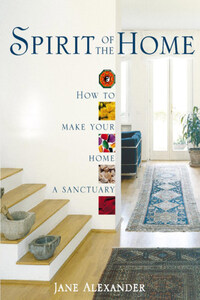COPYRIGHT
Thorsons
An imprint of HarperCollinsPublishers
1 London Bridge Street
London SE1 9GF
www.harpercollins.co.uk
First published by Thorsons 1998
This edition published 2018
FIRST EDITION
© Jane Alexander 2018
Cover layout design © HarperCollinsPublishers
Cover photograph © Alberto Piovano/Arcaid, Simon Brown/The Interior Archive, Shoji Sato/Photonica
A catalogue record of this book is available from the British Library
Jane Alexander asserts the moral right to be identified as the author of this work
All rights reserved under International and Pan-American Copyright Conventions. By payment of the required fees, you have been granted the nonexclusive, non-transferable right to access and read the text of this e-book on screen. No part of this text may be reproduced, transmitted, downloaded, decompiled, reverse engineered, or stored in or introduced into any information storage retrieval system, in any form or by any means, whether electronic or mechanical, now known or hereinafter invented, without the express written permission of HarperCollins e-books.
Find out about HarperCollins and the environment at www.harpercollins.co.uk/green
Source ISBN: 9780008317478
Ebook Edition © June 2018 ISBN: 9780008318093
Version 2018-07-04
INTRODUCTION
ALMOST ALL OF US have somewhere we call home. Whether it’s a large, grand house or simply a corner in a shared room, if we’re lucky we have a place we can claim as our own. Each and every one of us sees home in a different way: some of us might claim we barely think about home – it’s simply a place out of the elements where we eat and sleep. Others would insist that home is a vital part of life: a solid centre in which we can feel safe and secure. Yet more of us regard our homes as a symbol of taste and status, a means of indulging creativity or proving our social standing. However we experience home there is no doubt that the places in which we live are becoming more and more important to us. There is a huge proliferation of interest in houses, home-building, interior design and decoration. The newsstands are full to bursting with magazines on homes and gardens; coffee tables groan with glossy books showing perfect homes. Turn on the television and someone will be telling you how to revamp a kitchen or hide a radiator.
There’s far more to this than simply another fashionable trend. We have a deep collective yearning for an idealized image of home – for ideal homes. It’s as though we feel that if we could only make our homes look right, they would somehow be right. We would live perfect lives in our perfect homes. But if we think we can create a happy home from the pages of a magazine, if we think we can buy our way to a healing home, we are deluding ourselves.
This almost desperate interest in the external trappings of home – the newest colours, the latest furniture, the best cooker, the freshest curtains – disguises a more profound longing. In our hearts we want to come home to a real home. A real home is a place that nurtures us on every level. It gives us the creature comforts that make our bodies feel relaxed and comfortable. It provides the security and serenity that allow our minds and emotions peace and security. Above all, it nourishes our souls. A real home is not a show-home packed to the gills with expensive furniture, decorated by the most fashionable interior designer: it is a living space that has the power to make us feel safe in a troubled world. It is our refuge, our sanctuary – a place we can walk into and feel a sense of relief and relaxation as we shut the world behind us.
Some homes do this automatically. Others need our help. Sadly, over recent years we have been neglecting our homes or, more accurately, we’ve been ignoring the spirits of our homes. A home is far more than a physical structure; it is a living entity with a soul of its own. In the past the home was honoured as a deity – it was considered to have its own spirit and a host of attending spirits. All over the globe people acknowledged and venerated their homes, treating them with love and respect. Not to do so would be to bring trouble and strife on the house and its inhabitants. Nowadays we treat our homes poorly. Often we allow them to become dirty, cluttered and neglected. And even when we do carefully maintain and preserve the home, we run into the danger of turning our homes into stiff, stilted places of fashion and decorum – they look good but they don’t necessarily feel good. These ‘look-good’ houses exist because we have left out one vital part of the equation: we have ignored the home’s vital living energy, its spirit.








